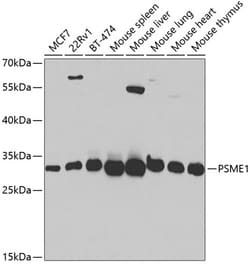Learn More
Invitrogen™ PSME1 Polyclonal Antibody


Rabbit Polyclonal Antibody
Supplier: Invitrogen™ PA5120905
Description
Positive test controls include: MCF7, 22Rv1, BT-474, Mouse spleen, Mouse liver, Mouse lung, Mouse heart, Mouse thymus. Immunogen sequence: MAMLRVQPEA QAKVDVFRED LCTKTENLLG SYFPKKISEL DAFLKEPALN EANLSNLKAP LDIPVPDPVK EKEKEERKKQ QEKEDKDEKK KGEDEDKGPP CGPVNCNEKI VVLLQRLKPE IKDVIEQLNL VTTWLQLQIP RIEDGNNFGV AVQEKVFELM TSLHTKLEGF HTQISKYFSE RGDAVTKAAK QPHVGDYRQL VHELDEAEYR DIRLMVMEIR NAYAVLYDII LKNFEKLKKP RGETKGMIY.
Proteolytic degradation is critical to the maintenance of appropriate levels of short-lived and regulatory proteins as important and diverse as those involved in cellular metabolism, heat shock and stress response, antigen presentation, modulation of cell surface receptors and ion channels, cell cycle regulation, transcription, and signalling factors. The ubiquitin-proteasome pathway deconstructs most proteins in the eukaryotic cell cytosol and nucleus. Others are degraded via the vacuolar pathway which includes endosomes, lysosomes, and the endoplasmic reticulum. The 26S proteasome is an ATP-dependent, multisubunit (approximately 31), barrel-shaped molecular machine with an apparent molecular weight of approximately 2.5 MDa. It consists of a 20S proteolytic core complex which is crowned at one or both ends by 19S regulatory subunit complexes. The 19S regulatory subunits recognize ubiquitinated proteins and play an essential role in unfolding and translocating targets into the lumen of the 20S subunit. An enzymatic cascade is responsible for the attachment of multiple ubiquitin molecules to lysine residues of proteins targeted for degradation. Several genetic diseases are associated with defects in the ubiquitin-proteasome pathway. Some examples of affected proteins include those linked to cystic fibrosis, Angelman's syndrome, and Liddle syndrome.
Specifications
| PSME1 | |
| Polyclonal | |
| Unconjugated | |
| PSME1 | |
| 11S regulator complex subunit alpha; 29-kD MCP activator subunit; activator of multicatalytic protease subunit 1; AW413925; epididymis secretory sperm binding protein Li 129m; HEL-S-129m; I79_008549; IFI5111; IGUP I-5111; interferon gamma up-regulated I-5111 protein; interferon-gamma IEF SSP 5111; interferon-gamma-inducible protein 5111; MGC8628; OTTHUMP00000164702; PA28 alpha subunit; PA28a; PA28alpha; protease (prosome, macropain) 28 subunit, alpha; proteasome (prosome, macropain) 28 subunit, alpha; proteasome (prosome, macropain) activator subunit 1; proteasome (prosome, macropain) activator subunit 1 (PA28 alpha); proteasome activator 28 subunit alpha; Proteasome activator complex subunit 1; proteasome activator subunit 1; Psme1; REGalpha; REG-alpha | |
| Rabbit | |
| Affinity Chromatography | |
| RUO | |
| 19186, 5720 | |
| -20°C, Avoid Freeze/Thaw Cycles | |
| Liquid |
| ELISA, Western Blot, Immunocytochemistry | |
| 0.41 mg/mL | |
| PBS with 50% glycerol and 0.02% sodium azide; pH 7.3 | |
| P97371, Q06323 | |
| PSME1 | |
| Recombinant fusion protein containing a sequence corresponding to amino acids 1-249 of human PSME1 (NP_006254.1). | |
| 100 μL | |
| Primary | |
| Human, Mouse | |
| Antibody | |
| IgG |
Your input is important to us. Please complete this form to provide feedback related to the content on this product.
